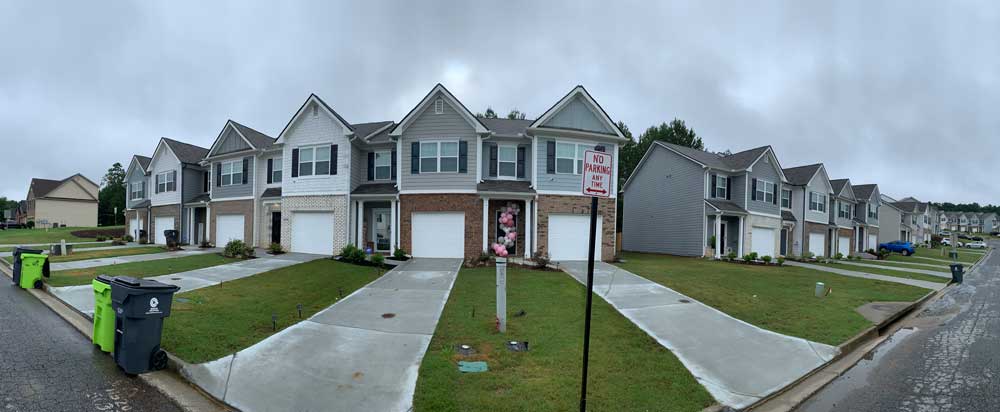“I assumed we would be looking to the inner city, because that’s where the poverty is,” Becky Hagarty said of her calling in 2001 to initiate a food pantry at Second Presbyterian Church. (See the related case study “Our Neighbors, Ourselves: Second Presbyterian Church and the Quest for Community Transformation.”) “When you want to do something, that’s where you go.”
Situated in a neighborhood where signs of affluence are all around, Second Presbyterian seemed to Hagarty to be miles away from any serious poverty. And that assumption that made sense for much of twentieth century. Poverty was concentrated mainly in rural communities and downtown districts and their surrounding neighborhoods. It was rare and largely invisible in the suburbs.
Not anymore. It’s often still somewhat invisible, but a sharp spike in suburban poverty is one of the striking trends of U.S. cities in the early twenty-first century. The trend holds true all across the U.S.
It began before the Great Recession of 2007-08, but the financial crisis accelerated the rising tide. Between 2000 and 2015, “suburbs in the country’s largest metro areas saw the number of residents living below the poverty line grow by 57 percent,” according to Brookings Institute analyst Elizabeth Kneebone.
As Kneebone notes, the rise of suburban poverty after 2000 “fueled a significant ‘tipping point’ in the geography of the nation’s poor. For the first time, suburbs became to more poor residents than cities”—16 million people versus roughly 13 million poor people in the cities and 8 million in rural areas. And the trend wasn’t limited to suburbs near downtown centers. Poverty is growing in all varieties of suburbs, including bedroom communities on the far edges of metropolitan areas.
The spike is driven by several factors. One is the broader crisis of affordable housing in the U.S. As many downtown centers gentrify and attract investment, the relatively affordable housing stock in the suburbs has become more attractive. A second factor is the suburbanization of the kind of manufacturing, construction, and retail jobs that low-income people often hold. A third factor is that the Great Recession of the late 2000s disproportionately affected those same sectors. Manufacturing, construction, and retail accounted for “60 percent of job losses in the 100 largest metro areas, and half of those job losses occurred more than 10 miles away from downtown,” according to Kneebone.
In addition to being a relatively new site of poverty, suburbs present serious challenges to rising out of it. Notably, they often lack easy access to public transportation, which tends to be concentrated in city centers. “On average, residents in low-income suburban neighborhoods that have access to transit can reach just 25 percent of metro area jobs in a 90-minute commute,” Kneebone observes. “The share of jobs reachable drops to 4 percent if the commute time is reduced to 45 minutes.” And government policies and programs aimed at relieving poverty often reflect outdated conceptions of it. For example, one analysis of suburbs found that “more than half lacked a food assistance provider, 61 percent had no registered abuse service providers, and 80 percent lacked a registered employment services provider.”
Rev. David Berry, associate pastor for mission at Second Presbyterian, confirmed that lack of access to resources—and to basic information about resources—is a serious obstacle for many of the people Second Presbyterian helps through its Northside Mission Ministry food pantry.
“Families don’t know where to go. There’s not a very good network, there’s not a consistent path for folks to follow to get the assistance they need,” he said. “One of the biggest problems is that, there may be assistance out there, but there’s such a disconnection in the community that people don’t know how to connect.”
These new realities about poverty have at least two key implications for congregations that aim to make a difference in poverty relief, beyond offering their own programs. One is that they can get behind public policies that have broad, bipartisan support—for example, by supporting better access to public transportation and affordable housing—without becoming entangled in partisan politics.
Another implication is that simply being an information resource can have a profound impact. Many congregational leaders and clergy do this informally in the course of carrying out their day-to-day work. But by formalizing and routinizing information sharing, congregations could multiply both their connections and their ability to serve people. Second Presbyterian, for example, started the Northside Partners Network as a way for local congregations and other organizations to meet regularly in a neutral space (i.e., a nearby township administrative office) and share information about the resources they offer while learning about what others offer.
Whether the goal is to initiate a food pantry, a community center, or some other program or approach, the key is relationship building. No single institution can come close to meeting all the needs. But building relationships increases the capacity to serve people on several levels—by offering more services at one’s own institutions, contributing to the efforts led by other institutions, and connecting people to local, perhaps little-known organizations that have the staff and resources to help them.
Written by Theodore M. Anderson




